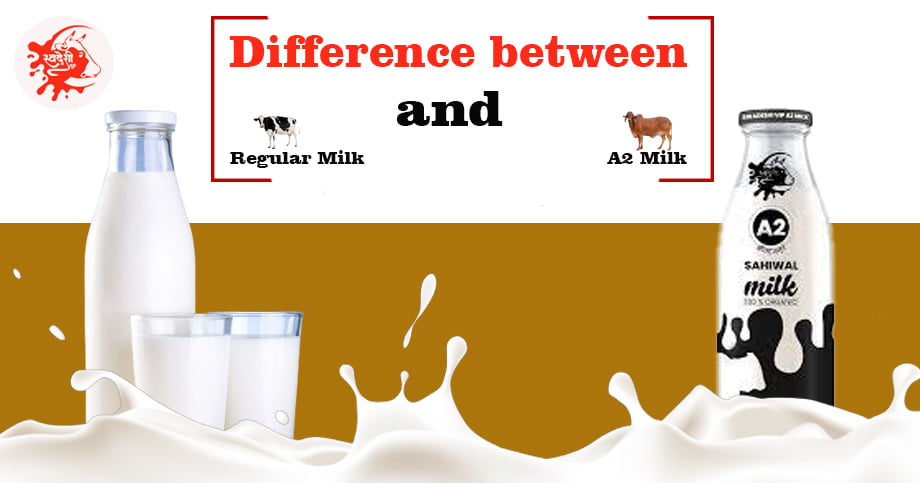
This blog will let you know about the difference between regular milk and A2 milk. As we all know, Cow milk is one of the most popular staple foods in the world. The health advantages of A2 milk and A2 dairy products on our body are very well known. In Indian households, drinking milk has been a cultural practice right from the Vedic period, when every family raised a cow or buffalo from which organic and pure milk was sourced. There has been a drastic change in milk consumption patterns as numerous options started prevailing in the dairy market. Usually, the health effects of consuming milk depend upon the breed of the cow it came from.
Various proponents have asserted that A2 cow milk provides numerous health benefits and is also safer for lactose intolerant individuals as it is easier to digest and shows no adverse effects. So, A2 cow milk is currently marketed as a healthier option than regular/A1 cow milk. So, let’s read more about the debated topic, which is what the difference between regular milk and A2 milk is.
All dairy product consumers must know the difference between regular milk and A2 milk. Humans rely upon cow milk for the most part when compared with other milk types. In the mid-nineteenth century, a few scientists observed that some substances in cow milk are causing health issues to people later, toward the end of the nineteenth century, some other experts observed that milk is of different classifications, some commonly noticed were A1 and A2, and they are generally consumed by people. When we study these two types of milk, the only difference in these two variations is the position of amino acids in their chain. For the most part, A2 or Desi breed cows are tracked down in Asia fundamentally in south-east Asia, particularly in India and a couple of districts of the African locale, and the A1 cow breed is found in European, American, and some other countries. When we consume milk, it usually breaks down into several components like proteins, but in the case of the A1 cow milk, it causes SIDS[1] and other chronic illnesses in children, whereas the A2 cow milk from the desi cow spices does break down into proteins however they get hydrated.
A1 milk type is usually produced by Karan Swiss, Holstein Friesian, Jersey, and a few other varieties which are normally found in Europe, Australia, and America, whereas A2 milk type is only produced by Bos-indicus breed cows like Gir, Kankrej, Sahiwal, Red Sindhi, and some others.
Casein is one of the largest protein groups in milk, making up around 80% of absolute protein content.
There are a few types of casein in milk. Beta-casein is the second most pervasive and exists in more than 13 different structures. It is a significant component of protein in cow’s milk, and various variations have been portrayed, including the A1 and A2 beta-casein types. The A1 and A2 beta-casein types differ in the 67th position in amino acid, being proline in the A2 β-casein and histidine proline in the A1 β-casein.
The two most common forms of Beta-casein:

A1 Beta-casein: Milk produced from cow breeds originating from northern Europe is, for the most part, high in A1 beta-casein. These cow breeds include Holstein, Friesian, Ayrshire, and British Shorthorn.
A2 beta-casein: The milk type that contains A2 beta-casein is essentially produced by cow breeds that are usually found in Asia and African locales, like Gir, Kankrej, Sahiwal, and Red Sindhi and some others.
There is a wide range of substantial difference between regular milk and A2 milk. Here, A1 milk is termed as regular milk. To pursue a healthy lifestyle, understanding the distinction between the two types of milk is very significant. A1 cow milk is the most easily accessible and the most generally consumed milk type today. A1 milk is acquired from cows of Western origin like Jersey, Holstein Friesian, and various others, and these cows yield huge amounts of milk. Whereas A2 cow milk, then again, is produced from cows of Indian origin like Gir, Sahiwal, and so on, which might give generally lesser milk.
Albeit the fact that both the milk types come from the very same source that is the cow, there is an impressive distinction in their chemical compositions. There is a major difference in the proportions of lactose (carbohydrate component) and unsaturated fats (fat) in the two sorts of milk. Nonetheless, the protein part in the milk separates the two from one another concerning quality. A1 milk has an A1 kind of protein (casein), and A2 milk has an A2 protein type (casein component). It is crucial because the milk is broken into components and how it is metabolized in our system.
When we talk about availability, A1 cow milk is moderately less expensive and easier to find than A2 cow milk. However, with the recent changes in opinion about the health benefits/effects offered by these milk types, A2 cow milk is high in demand. A2 milk is high in demand due to its medical advantages. One of the significant explanations for this discussion is the presence of BCM-7 (Beta-casomorphine-7) in the A1 milk type, which is absent in the A2 milk type and has been considered liable for several harmful health consequences. After understanding the difference between regular milk and A2 milk, consumers will make a sureshot switch.
Beta-casomorphin-7 (BCM-7) is a kind of opioid peptide delivered during the absorption of A1 beta-casein. It’s the only reason why certain individuals believe the A1 milk type to be less healthy than the A2 milk type.
At the point when our body attempts to break down casein in regular milk, a chemical component called BCM-7 is produced, which is the reason for morphine-like impacts on our Central Nervous system. BCM-7 makes us addicted to milk. Subsequently, kids like to consume milk regularly. Neuro issues like mental problems, which influence learning capacity and trigger aggravated symptoms of autism, are likewise caused by A1 cow milk as a result of the presence of a morphine-like compound. The morphine impact also causes constipation. Subsequently, kids who consume A1 cow milk are normally constipated. A1 cow milk protein has ‘Histidine’ at its 67th position, which forms Histamine (causing allergic responses). However, kids will quite often also develop allergic dermatitis (sensitivity to the skin), asthma, allergic cough, and allergic rhinitis (running nose). Carbohydrate metabolism and lipid can also affect those who are regularly consuming A1 milk type, causing long-term risks of diabetes and obesity.
Moreover, lactose intolerance is also high in regular milk types. Carbohydrates and fat content in A1 milk type support the development of undesirable microscopic organisms in the human digestive system, leading to reduced immunity in children. Studies have shown that drinking A1 milk could adversely influence the neurohormonal framework and cause type 1 diabetes, heart diseases, infant deaths, digestive issues, and autism.
One of the major points encompassed in the difference between regular milk and A2 milk is the protein factor.
After going through the difference between regular milk and A2 milk, picking the right fit is easy. A2 Cow Milk contains minerals like potassium, calcium, and phosphorus, which are highly vital for our bones and teeth health, better working of muscles, tissue and cell development, regulation of blood pressure, enhancement of good cholesterol (HDL), and maintaining overall well-being and nourishment of the body.
A2 Cow Milk likewise has fundamental Vitamins like Vitamin A, D, and B12 which are essential for bones and teeth, boosting immunity levels and converting food into energy. A2 organic milk also contributes to increasing metabolism, building immunity, and providing Omega 3 unsaturated fats. These unsaturated fats contribute exceptionally to mental health development as well.
Well before Gir cow milk was viewed as a better option by modern science, Ayurveda knew its various advantages.
Following are the A2 organic milk benefits quoted by Ayurveda:

Before opting for the milk choice, analyzing the difference between regular milk and A2 milk is crucial.
Conclusion:
I hope you have understood the difference between regular milk and A2 milk. Research has recommended that A1 beta-casein might cause stomach-related side effects in specific people. Various proponents have asserted that A2 cow milk provides numerous health benefits and is also safer for lactose intolerant individuals as it is easier to digest and shows no adverse effects. So, A2 cow milk is marketed as a healthier option than regular/A1 cow milk. Be that as it may, the proof is still feeble for any strong end to be made about the alleged connections between A1 beta-casein and different circumstances, like Type 1 Diabetes and Autism.
Read Our Article: A1 vs A2 Milk: Difference between A1 and A2 Milk in Detail
